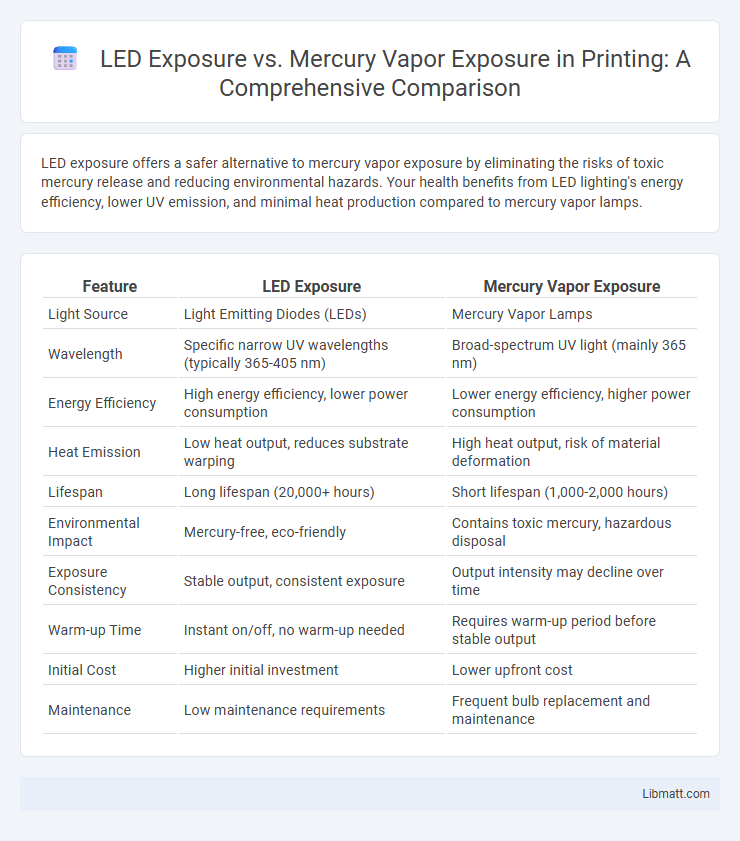LED exposure offers a safer alternative to mercury vapor exposure by eliminating the risks of toxic mercury release and reducing environmental hazards. Your health benefits from LED lighting's energy efficiency, lower UV emission, and minimal heat production compared to mercury vapor lamps.
Table of Comparison
| Feature | LED Exposure | Mercury Vapor Exposure |
|---|---|---|
| Light Source | Light Emitting Diodes (LEDs) | Mercury Vapor Lamps |
| Wavelength | Specific narrow UV wavelengths (typically 365-405 nm) | Broad-spectrum UV light (mainly 365 nm) |
| Energy Efficiency | High energy efficiency, lower power consumption | Lower energy efficiency, higher power consumption |
| Heat Emission | Low heat output, reduces substrate warping | High heat output, risk of material deformation |
| Lifespan | Long lifespan (20,000+ hours) | Short lifespan (1,000-2,000 hours) |
| Environmental Impact | Mercury-free, eco-friendly | Contains toxic mercury, hazardous disposal |
| Exposure Consistency | Stable output, consistent exposure | Output intensity may decline over time |
| Warm-up Time | Instant on/off, no warm-up needed | Requires warm-up period before stable output |
| Initial Cost | Higher initial investment | Lower upfront cost |
| Maintenance | Low maintenance requirements | Frequent bulb replacement and maintenance |
Understanding LED and Mercury Vapor Light Sources
LED light sources use semiconductor technology to emit bright, energy-efficient light with minimal heat output and longer lifespan compared to mercury vapor lamps. Mercury vapor lights rely on an electric arc through vaporized mercury, producing intense light but consuming more energy and containing toxic mercury, posing disposal challenges. Your choice between LED and mercury vapor should consider energy efficiency, environmental impact, and maintenance requirements for lighting applications.
Health Impacts of LED Exposure
LED exposure primarily affects eye health through prolonged blue light emission, which can cause digital eye strain and disrupt circadian rhythms by interfering with melatonin production. Unlike mercury vapor lamps, which pose toxicity risks from mercury exposure, LEDs do not contain hazardous materials but may still contribute to headaches, sleep disturbances, and retinal stress with excessive use. Your careful management of screen time and proper lighting conditions can minimize adverse health impacts linked to LED exposure.
Health Risks Associated with Mercury Vapor Exposure
Mercury vapor exposure poses significant health risks including neurological damage, respiratory issues, and kidney toxicity due to its high toxicity and ability to accumulate in the body. Unlike LED exposure, which emits low levels of safe visible light, mercury vapor presents dangers through inhalation or skin contact with elemental mercury or its vapors. Protecting Your environment from mercury vapor is essential to prevent long-term health complications and ensure safety.
Comparative Analysis: LED vs Mercury Vapor Light Spectrum
LED lighting emits a narrow, well-defined spectrum with a high proportion of blue wavelengths, promoting energy efficiency and longer lifespan while minimizing harmful ultraviolet radiation. Mercury vapor lamps produce a broader spectrum, including significant ultraviolet and infrared emissions, leading to higher heat output and potential health risks from prolonged exposure. Understanding your exposure to these light sources helps optimize safety and illumination quality for indoor and outdoor environments.
Environmental Implications of Mercury Vapor Lamps
Mercury vapor lamps release toxic mercury into the environment, posing significant risks to ecosystems and human health due to mercury's bioaccumulative properties. Your choice to use LED lighting reduces hazardous waste generation, as LEDs contain no mercury and offer higher energy efficiency, lowering overall environmental impact. Proper disposal of mercury vapor lamps is crucial to prevent soil and water contamination, highlighting the environmental benefits of switching to mercury-free LED technology.
Safety Standards for LED and Mercury Vapor Lighting
Safety standards for LED lighting are governed by organizations such as the Illuminating Engineering Society (IES) and the International Electrotechnical Commission (IEC), ensuring low ultraviolet (UV) emissions and minimal risk of hazardous exposure. Mercury vapor lamps, regulated by agencies like the Environmental Protection Agency (EPA) and the Occupational Safety and Health Administration (OSHA), require strict handling protocols due to mercury's toxicity and potential for environmental contamination. Your awareness of these standards helps ensure safer use and compliance when selecting lighting solutions for indoor or outdoor environments.
Ultraviolet Emission Differences: LED vs Mercury Vapor
Ultraviolet emission from LED lights is significantly lower compared to mercury vapor lamps, which emit a broad spectrum of UV radiation, including harmful UV-C rays. This lower UV output makes LED lighting safer for prolonged exposure, reducing the risk of skin and eye damage. Your environment benefits from LEDs by minimizing UV-related health hazards commonly associated with mercury vapor exposure.
Occupational Risks: Working with LED and Mercury Vapor Lights
Occupational risks from working with LED lights primarily involve blue light exposure, which can cause eye strain and retinal damage over prolonged periods. Mercury vapor lighting poses greater hazards due to mercury's toxic properties, risking inhalation of hazardous vapors and skin contact with mercury-containing components. Ensuring your workplace has proper ventilation and protective equipment is critical to minimizing health risks associated with both types of lighting.
Longevity and Maintenance: LED vs Mercury Vapor Bulbs
LED bulbs typically offer a lifespan of 25,000 to 50,000 hours, significantly outlasting mercury vapor bulbs which average around 15,000 to 24,000 hours. Maintenance for LED lighting is minimal due to their solid-state construction and resistance to shock and vibration, whereas mercury vapor bulbs require more frequent replacements and careful handling due to their fragile glass and toxic mercury content. This results in lower long-term operational costs and less environmental hazard for LED systems compared to mercury vapor lighting solutions.
Future Trends in Lighting Technology and Human Exposure
Future trends in lighting technology emphasize the shift from mercury vapor lamps to energy-efficient LED lighting to reduce hazardous mercury exposure. LEDs offer lower ultraviolet emission and minimal toxic chemical risks, promoting safer indoor and outdoor environments. Innovations in LED design aim to optimize light quality and minimize blue light exposure, addressing potential health concerns linked to prolonged use.
LED exposure vs mercury vapor exposure Infographic

 libmatt.com
libmatt.com